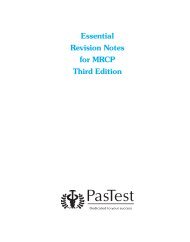ACCESS TO SURGERY: 500 SINGLE BEST ANSWER ... - PasTest
ACCESS TO SURGERY: 500 SINGLE BEST ANSWER ... - PasTest
ACCESS TO SURGERY: 500 SINGLE BEST ANSWER ... - PasTest
Create successful ePaper yourself
Turn your PDF publications into a flip-book with our unique Google optimized e-Paper software.
SECTION 1:GENERAL PHYSIOLOGY –<strong>ANSWER</strong>S1.1Answer: CGap junctionsgeneralA gap junction is a junction between certain animal cell typesthat allows different molecules and ions to pass freely betweencells. The junction connects the cytoplasm of cells. One gapjunction is composed of two connexons (or hemichannels), whichconnect across the intercellular space. They are analogous to theplasmodesmata that join plant cells. In vertebrates, gap-junctionhemichannels are primarily homo- or hetero-hexamers of connexinproteins. Invertebrate gap junctions comprise proteins from thehypothetical innexin family. However, the recently characterisedpannexin family, functionally similar but genetically distinct fromconnexins and expressed in both vertebrates and invertebrates,probably encompasses the innexins. Gap junctions formed fromtwo identical hemichannels are called homotypic, while those withdiffering hemichannels are heterotypic. In turn, hemichannels ofuniform connexin composition are called homomeric, while thosewith differing connexins are heteromeric. Channel composition isthought to influence the function of gap-junction channels but it isnot yet known how.Gap junctions:• allow for direct electrical transmission between cells• allow for chemical transmission between cells, throughthe transmission of small second messengers, such asIP 3and Ca 2+• allow any molecule smaller than 1 kDa to pass through.201
















